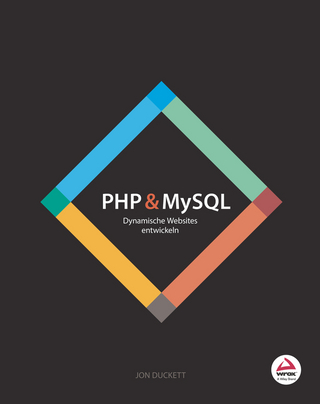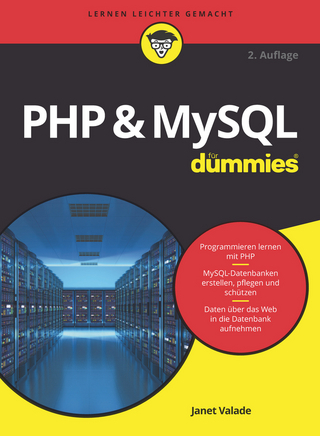
Brilliant MySQL and PHP
Prentice-Hall (Verlag)
978-0-273-72154-3 (ISBN)
- Titel ist leider vergriffen;
keine Neuauflage - Artikel merken
Table of Contents Part I: Getting started, Choosing the right version, and Installing MySQL Chapter 1: Getting started with MySQL and PHP (9 pp.) Introduction The open source revolution a brief history Relational databases a brief description Data-driven websites a brief description MySQL and PHP Support Options Cost Chapter 2: Choosing the right version of MySQL and PHP (16 pp.) Introduction Features and limitations of MySQL Community and Enterprise servers BOXOUT: Comparing Community and Enterprise MySQL TASK: MySQL Community Server Going it alone TASK: MySQL Enterprise Server when it has to work Features and limitations of PHP servers BOXOUT: Comparing Community PHP versions TASK: PHP.net Going it alone TASK: PHP Zend Core when it has to work Chapter 3: Installing MySQL (19 pp.) Introduction Preparing for your install BOXOUT: MySQL hardware requirements BOXOUT: MySQL software requirements TASK: Installing MySQL Community Server BOXOUT: Getting Help with the Community Server Install TASK: Installing MySQL Enterprise Server BOXOUT: Getting Help with the Enterprise Server Install TASK: Installing MySQL graphical user interface (GUI) tools Chapter 4: Installing PHP (19 pp.) Introduction Preparing for your install BOXOUT: PHP hardware requirements BOXOUT: PHP software requirements TASK: Installing PHP. BOXOUT: Getting Help with the PHP.net Server Install TASK: Installing Zend Core PHP Server BOXOUT: Getting Help with the Zend Core PHP Install TASK: Installing PHP with a graphical user interface (GUI) tools Chapter 5: Installing PHPNuke (12 pp.) Introduction Preparing for your install BOXOUT: PHPNuke hardware requirements BOXOUT: PHPNuke software requirements TASK: Installing PHPNuke. BOXOUT: Getting Help with the PHPNuke Server Install BOXOUT: Confirming your PHPNuke install Part II: Planning, Creating, and using your own databases and websites Chapter 8: Planning your PHPNuke site capturing your users (21pp.) Introduction Planning website organization, content, and structure Organizing your website Data-driven websites BOXOUT: Website organization - a brief introduction Elements of a website BOXOUT: The user experience Navigation Content Search engine tips Planning your website determine what you want your visitor to: do, buy, or learn then work backwards TASK: Planning your Navigation TASK: Planning your Content TASK: Planning your search engine strategy Chapter 6: Creating your first PHPNuke website (19 pp.) Introduction In and around PHPNuke PHPNuke modules and plug-ins BOXOUT: Additional Resources for PHPNuke TASK: Locating additional modules TASK: Installing downloaded modules BOXOUT: Additional resources for finding additional modules TASK: Create a navigational menu item TASK: Create a page using standard modules TASK: Configure module to access data TASK: Add content to a webpage Chapter 7: Custom Site Planning and deploying: Building the database (21pp.) Introduction Planning database access, organization, and structure Accessing your database Data-driven websites Application access using an open database connector (ODBC) BOXOUT: Normalization a brief introduction Elements of a database BOXOUT: Data elements at a glance: tables, views, and procedures Tables Views Procedures Planning your database start with the desired output and work backwards TASK: Planning your data tables TASK: Planning your views TASK: Planning your procedures TASK: Planning to secure your data Chapter 9: Custom Site Planning and deploying: Building your first MySQL database (19 pp.) Introduction Structured Query Language (SQL) commands and structures BOXOUT: The 10 most used SQL commands Creating the database TASK: Create a database TASK: Alter a database TASK: Remove a database Tables TASK: Creating a table TASK: Altering a table TASK: Inserting data into a table TASK: Updating data in a table TASK: Viewing data in a table Views TASK: Creating a view BOXOUT: Understanding joins and how to use them TASK: Altering a view TASK: Inserting data into a view TASK: Updating data in a view TASK: Viewing data in a view Procedures TASK: Creating a procedure TASK: Altering a procedure TASK: Executing a procedure TASK: Updating data with a procedure Logins TASK: Creating a login TASK: Deleting a login TASK: Granting database rights to a login TASK: Revoking database rights to a login Chapter 10: Get your data using Microsoft Excel or Internet Information Server (IIS) (18 pp.) Introduction Access your database from IIS TASK: Create an ODBC connection TASK: Create a basic data-driven webpage with FrontPage BOXOUT: Additional resources for creating data-driven webpage Access your database from Excel TASK: Create an ODBC connection TASK: Create a linked spreadsheet TASK: Import data from your database BOXOUT: Additional resources for creating data-driven spreadsheets Part III: Maintaining the server, websites, and databases Chapter 11: Backup and restore MySQL databases (20 pp.) Introduction Backing up your MySQL data BOXOUT: Overview of data storage media TASK: Backup a single database TASK: Backup multiple databases Restoring your MySQL data TASK: Restoring a single database TASK: Restoring multiple databases Chapter 12: Upgrading the MySQL server (22 pp.) Introduction Why should I upgrade? TASK: Upgrading the MySQL community server BOXOUT: Additional resources for community server TASK: Upgrading the MySQL enterprise server BOXOUT: Additional resources for enterprise server Chapter 13: Monitoring the MySQL server (23 pp.) Introduction Monitoring the MySQL server TASK: Monitoring the community server BOXOUT: Additional resources for monitoring community server TASK: Monitoring the enterprise server BOXOUT: Additional resources for monitoring enterprise server Getting notified when errors occur TASK: Setting up email notifications TASK: Setting up pager notifications Chapter 14: Tuning the MySQL server and databases (25 pp.) Introduction Tuning the MySQL server and databases keeping it all working smoothly BOXOUT: Five performance boosting tips Monitoring the server TASK: Configure server monitoring for databases BOXOUT: Additional monitoring resources for MySQL server Tuning the server BOXOUT: Additional tuning resources for community server BOXOUT: Additional tuning resources for enterprise server TASK: Tuning startup parameters TASK: Increase server buffer size TASK: Decrease buffer size BOXOUT: How does MySQL use the buffer to enhance performance? TASK: Controlling the query optimizer BOXOUT: How does MySQL use the query optimizer to enhance performance? Tuning your databases BOXOUT: How does MySQL use indexes to enhance performance? TASK: Creating column indexes TASK: Creating multi-column indexes Chapter 15: Tuning the PHP server and websites (10 pp.) Introduction Tuning the PHP server and websites BOXOUT: Five performance boosting tips Monitoring the server TASK: Configure server monitoring for website management BOXOUT: Additional monitoring resources for PHP server Tuning the server BOXOUT: Additional tuning resources for PHP server Chapter 16: Troubleshooting (35 pp.) Appendix A: Finding free and professional MySQL server support Appendix B: Finding free and professional PHP server support Appendix C: Finding additional Structured Query Language resources Appendix D: Glossary
| Erscheint lt. Verlag | 3.2.2010 |
|---|---|
| Verlagsort | Harlow |
| Sprache | englisch |
| Maße | 187 x 234 mm |
| Themenwelt | Informatik ► Datenbanken ► MySQL |
| ISBN-10 | 0-273-72154-2 / 0273721542 |
| ISBN-13 | 978-0-273-72154-3 / 9780273721543 |
| Zustand | Neuware |
| Haben Sie eine Frage zum Produkt? |
aus dem Bereich


